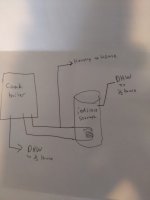I am upgrading my old boiler and gas water heater because of a remodel and relocating the boiler location. My first thought was to go with a tankless combi boiler however with six people (2 adults, 4 kids under 8) in our house the domestic hot water flow rate of 3.6 seems like it may be a challenge. Also the combi will be located in the basement with 2.5 baths (one bathroom on the second floor, one in the basement, and the half bath on first floor.)
I am thinking about going with the combi boiler and seeing how it works in our house. If in the future there is too much waiting for hot water on the second floor or hot water flow rate issues would it be possible to add an indirect in the basement for the half bath and the bath on the second floor off of the heat side of the combi and having the bathroom in the basement supplied by the on-demand part of the combi?
I also looked at a condensing boiler with an indirect setup but I was told there isn't an advantage to getting the condensing boiler over the combi boiler. I am not sure if that is correct. Are there advantages of a condensing boiler over the combi?
I am thinking about going with the combi boiler and seeing how it works in our house. If in the future there is too much waiting for hot water on the second floor or hot water flow rate issues would it be possible to add an indirect in the basement for the half bath and the bath on the second floor off of the heat side of the combi and having the bathroom in the basement supplied by the on-demand part of the combi?
I also looked at a condensing boiler with an indirect setup but I was told there isn't an advantage to getting the condensing boiler over the combi boiler. I am not sure if that is correct. Are there advantages of a condensing boiler over the combi?

